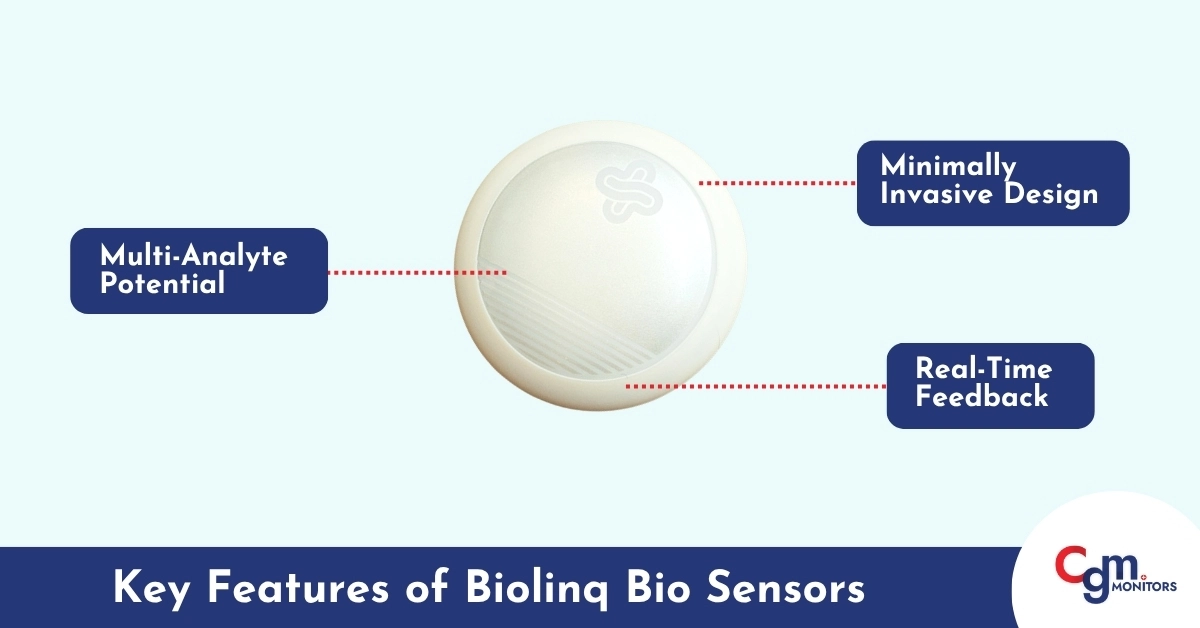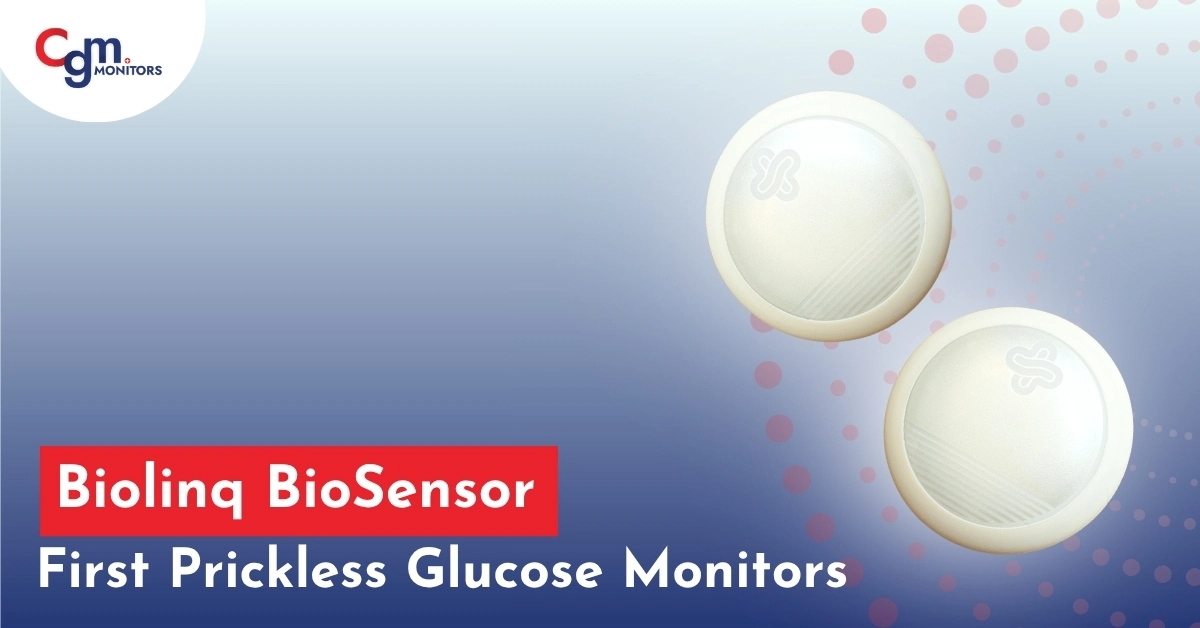Table of content
Biolinq, headquartered in San Diego, California, has recently secured funding to advance its flagship device, a wearable biosensor named Biolinq Shine. Described as a fully autonomous, needle-free glucose sensor, the Biolinq BioSensors are going to be the first prickless glucose monitors. The best part is that these sensors will not only tell you your glucose level, but also your lactate and ketone levels.
Using an array of microsensors (microneedle / micro-electrochemical elements), the sensor sits in the intradermal layer (just beneath the skin surface), not even as deep as the current CGM’s (continuous glucose monitors) filament sits.
Biolinq Biosensors Usage
The device includes a colour-coded LED display built into the patch itself (no phone required to see basic glucose status) — e.g., “blue = in target, yellow = high”. With autonomous operation and qualitative glucose values with easy LED light, and the possibility of seeing more detailed data in the app, this system can help in both a quick glance at your glucose range, i.e., normal or high, and detailed insights for making lifestyle changes leading to better diabetes management.
Currently, the FDA has granted de novo classification (includes low to moderate risk and is limited to investigational uses only) for Biolinq Shine.
Using Biolinq Sensor – Eligibility and Limitations
Expected to first gain FDA approval for type 2 diabetics and gradually expand the coverage.
The minimum age to use Biolinq has not been confirmed yet. Because the sensor uses microsensors providing shallow insertion, it is described as virtually painless and needle-free. Unlike filament CGMs, biolinq sensors do not require hypodermic needles.
Important:
On top of only getting a limited/restricted approval from the FDA, the Biolinq Biosensor’s accuracy has also not been confirmed. While the CGM sensors, such as the Freestyle Libre 2 Plus Sensors, boast accuracy suitable for making informed decisions.
Key Features of Biolinq Bio Sensors
The Biolinq Bio Sensor represents a new generation of glucose monitoring technology, offering a user-friendly and highly advanced approach to continuous health tracking. Here are its standout features:
1. Minimally Invasive Design
Biolinq sensors use a microneedle-like insertion technology that penetrates only the upper layer of the skin. This eliminates the need for traditional hypodermic needles — minimizing pain, bleeding, and scar tissue formation, making the application nearly painless and more comfortable for daily wear.
2. Real-Time Feedback
Unlike many CGMs that rely solely on mobile apps, Biolinq features an on-device display that provides instant glucose readings. This enables users to immediately understand how specific foods, activities, or lifestyle choices affect their glucose levels — encouraging better self-management and quick decision-making.
3. Multi-Analyte Potential
The Biolinq platform is designed to be multi-analyte capable, meaning it can eventually monitor multiple biomarkers beyond glucose. Future developments aim to include ketone and lactate measurements, offering deeper insights into metabolism, exercise performance, and overall health.

Working of Miniature Electrochemical BioSensor Biolinq
The sensor is positioned in the intradermal layer — very shallow insertion compared to subcutaneous sensors. It avoids the need for a thick filament or deep needle.
Behind the scenes, an array (multiple microsensors) uses electrochemical detection of glucose — likely relying on enzyme reactions or similar electrochemical transduction.
Because the sensors sit very shallow, diffusion distances are much smaller, improving responsiveness. The company claims its sensors are up to 20× more shallow than conventional filament-based CGMs.
The sensor measures interstitial glucose (not direct blood glucose) and records the trend over time.
The on-patch LED display gives qualitative feedback (e.g. in target vs above target) in real time. More detailed quantitative data (glucose trend graphs, numeric values) are shown in a companion app.
While these miniature electrochemical sensors can be extremely advantageous, they may have some limitations, e.g., not being able to work properly under tough factory conditions.
Head-to-Head Comparison of Biolinq, Libre and Dexcom
Here is a comparison table (as of currently available public data):
| Feature | Biolinq Shine | Dexcom or FreeStyle Libre (e.g., G7 / Libre 2 Plus or 3 Plus) |
| Insertion/needle use | Microneedle / intradermal microsensors, no hypodermic needle | Hypodermic filament/electrode inserted with applicator |
| Color display on the sensor itself | Built-in color LED for in-range / high cues | No built-in LED on sensor; display via app or receiver |
| Quantitative readings/trends | LED gives qualitative signals; full data via app when placed close to the compatible phone | Real-time numeric + trend predictions on app/receiver |
| Target users/indication | Only non–insulin Type 2 initially; expansion expected in the future | Works for Type 1 and Type 2 (insulin users) in many markets, including the US. |
| Age indication | 22 years + (per current de novo classification clearance) – according to the info shared by the pharmacytimes | Dexcom G7, Libre 3 + and 2+ are approved for children aged 2+ in many markets |
| Sensor depth (how deep the sensor sits) | Very shallow intradermal (claimed ~20× more shallow vs filament CGM) | Subcutaneous (a filament several mm deep) |
| Alarm/alerts | LED signals; the app is expected to deliver more alerts | Full alarms for high/low glucose via app/receiver |
| Intended use/dosing | Not intended for direct insulin dosing — qualitative guidance and behaviour insights | Approved for use in insulin decision support and integration with pumps |
| Regulatory status | FDA de novo clearance for a new category | Dexcom CGMs are FDA-cleared / approved |
| Strengths | Built-in colour signals, minimal needle feel, integrated activity/sleep | High quantitative accuracy, full alerting, and insulin integration |
| Limitations (so far) | Only non-insulin Type 2, limited age range, qualitative display only | Requires subcutaneous insertion, cost, occasional calibration/lag |
Conclusion
Biolinq biosensors may lead to an easier diabetes management era – less pain and more insights. Unlike the filament-based CGMs (continuous glucose monitors), the biolinq patch sits on your skin (probably the upper arm) with the help of microsensors.
However, please note that it’s not truly non-invasive in the sense of completely external — it penetrates just beneath the skin surface (intradermally) but much more shallowly than traditional CGMs.
Disclaimer: This blog is for informational purposes only and does not constitute medical, legal, or professional advice. While we strive for accuracy, errors or omissions may occur.
Some images in this blog may be AI-generated or for illustrative purposes only. Device images belong to their respective manufacturers and are used here for reference. Actual products may vary.
Frequently Asked Questions
How accurate are Biolinq biosensors compared with other CGMs (e.g., Dexcom, Libre)?
Biolinq biosensors offer accuracy comparable to leading CGMs like Dexcom and Libre, thanks to advanced microneedle technology that captures real-time glucose levels directly from interstitial fluid with minimal delay.
Is the Biolinq biosensor FDA-cleared or approved?
As of now, Biolinq is in the final stages of FDA review for clinical use, with early data showing strong potential for regulatory approval soon.
Who is the Biolinq biosensor intended for — Type 1, Type 2, or wellness users?
Biolinq is being designed for both people with diabetes and those focused on metabolic wellness, offering glucose insights for lifestyle optimization as well as diabetes management.
How long does a Biolinq biosensor last (wear time)?
Each Biolinq biosensor is designed for multi-day wear, typically lasting up to 7 days, providing continuous real-time glucose tracking without fingersticks.
Can I shower or exercise while wearing a Biolinq biosensor?
Yes, Biolinq is water-resistant and sweat-proof, allowing users to shower, swim, or exercise without disrupting glucose monitoring.
Do I need a prescription to buy Biolinq, and will insurance cover it?
Initially, Biolinq may require a prescription for diabetic users, but wellness versions are expected to be available over the counter. Insurance coverage will depend on your plan and medical eligibility.
How do I interpret readings from the Biolinq app/device?
The Biolinq app delivers easy-to-understand glucose trends, personalized insights, and real-time feedback to help you make smarter lifestyle and dietary choices.
Can I use Biolinq with third-party apps or an Apple Watch?
Yes, Biolinq is designed to integrate seamlessly with compatible health apps and wearables like the Apple Watch, enhancing convenience and data tracking.
How much does Biolinq cost (device and monthly fees)?
Official pricing hasn’t been released yet, but Biolinq is expected to offer a subscription-style model similar to other CGMs, making it more affordable for long-term use.







Write a comment
Your email address will not be published. All fields are required